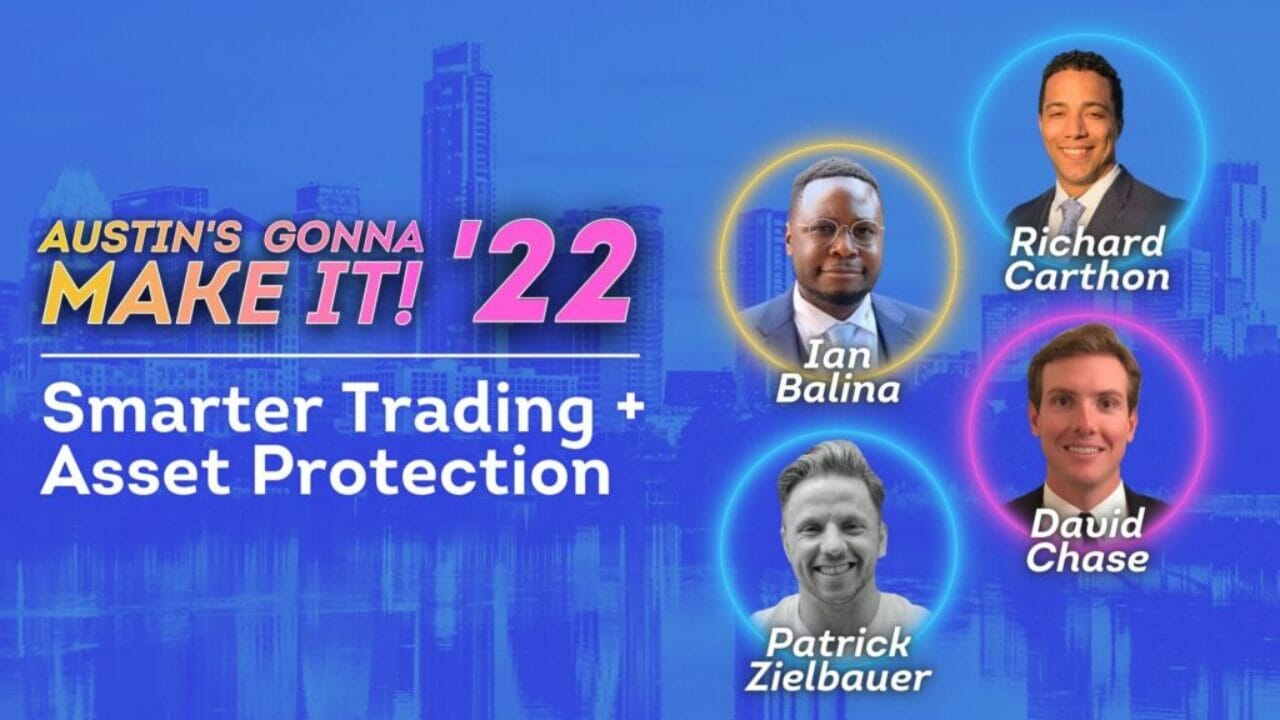A Masterclass in Smarter Trading & Asset Protection with Ian Balina, David Chase, Patrick Zielbauer and Richard Carthon at AGMI 2022 (Episode 326)
A Masterclass in Smarter Trading & Asset Protection with Ian Balina, David Chase, Patrick Zielbauer and Richard Carthon at AGMI 2022
This panel includes:
MODERATOR: Richard Carthon – CEO of Crypto Current
SPEAKER: Ian Balina – CEO of Token Metrics
SPEAKER: David Chase – Managing Partner of Crescent City Capital, Acacia Digital, & Evolve Energy Partners
SPEAKER: Patrick Zielbauer – Global Strategic Account at Blockfills
Want more resources around this podcast? Keep up to date on the latest articles here.
The following transcript was created using artificial intelligence. There will be some grammatical errors below.
00:00:51:18 – 00:01:14:28
Steve: All right, everybody. We are about to get into our final panel for the day, but please be advised, we will be opening up our happy hour after this. If you want to go out through the double curtains, we will be opening up that networking happy hour after this session. But if you would be so kind to take a seat and join me in welcoming our next set of panelists,
00:01:16:15 – 00:01:39:18
Steve: we are welcoming to the stage Richard Carton, the CEO of Cryptocurrency. Ian Balina, CEO of Token Metrics. David Chase, the managing partner of Crescent City Capital, Acacia Digital and Evolve Energy Partners. And Patrick Ziel Bower, the director of global sales for BLOCK Fills. So please give me a warm round of applause for them.
00:01:51:06 – 00:01:52:01
Richard Carthon: All right.
00:01:53:24 – 00:02:24:12
Richard Carthon: Well, it’s been a great day. Hope you have enjoyed all the great content that we have been sharing. But we are going to finish with a bang. Lots been going on in the market and a lot of people kind of want to hear some different takes. So, as you all know, this is going to be the panel about smarter trading and things you can be doing into the future. And so I’m Richar Carthon, as Steve said, one of the founders of cryptocurrency, helping to bridge the gap between people know nothing about the space with thought leaders and providing, you know, solid educational content for that.
00:02:24:14 – 00:02:34:03
Richard Carthon: And you know we’re helping to put on agri us is going to make it and have the pleasure of being on this amazing panel with David and and Patrick, and I’ll let them do a quick little intro themselves and we’ll go ahead and dive in.
00:02:35:16 – 00:03:11:27
David Chase: All right. So, Richard, thanks for putting this together, man. And you did a really good job. Stephen Thank you. So, David Chase, So I manage along with Richard and Hunter, who is here as well, three crypto ventures all working, I believe, very synergistically with each other. Crescent City Capital, which is Multi-strategy hedge fund we launched in late 18 or early 19. We have Acacia Digital, which we launched about a year ago, which is early stage VC or early stage Blockchain VC fund.
00:03:12:18 – 00:03:18:17
David Chase: And then we have our mining fund. We mine exclusively Bitcoin now, which is of of energy partners.
00:03:20:06 – 00:03:32:06
Balina: All right. Good afternoon. I mean, Balina founder and CEO of Token Metrics. We’re an air driven crypto analytics platform. Also the Partner Token Metrics Ventures, which is a Multi-strategy crypto hedge fund and VC fund.
00:03:33:24 – 00:04:04:15
Patrick Zielbauer: Good afternoon, everybody. My name is Patrick Zielbauer . I am the director of sales for BLOCK Fills. BLOCK Fills is a liquidity and technology provider to institutions in the digital asset space. We provide liquidity in spot derivative and lending markets, both over-the-counter and API driven, and our clients are mainly multi-strategy hedge funds, asset managers, digital banks, exchanges, other OTC desks, payments companies and other institutions looking to participate in this very exciting space.
00:04:04:17 – 00:04:05:02
Steve: Thanks for coming.
00:04:06:03 – 00:04:32:25
Richard Carthon: Awesome. Well, excited to have you all. It’s super easy to train in a bull market and pretty much put your money in something and all of a sudden it goes up. It’s a different story when it’s a bear market, and we have now been in our market basically since the beginning of the year and it could potentially be extended out. What are things that people can be doing right now to start to plan and be able to be a smarter trader right here in this moment during this bear market? They’ve been kicked off.
00:04:33:06 – 00:04:34:27
David Chase: Okay. So
00:04:36:21 – 00:04:43:21
David Chase: when I started trading, you know, ten years ago and obviously a lot different markets, there was a saying here, I’m sure you guys have all heard
00:04:45:19 – 00:05:16:04
David Chase: bulls make money, bears make money, pigs get slaughtered. And, you know, the idea here is, is that you obviously don’t want to don’t want to be greedy. So, you know, I think that the you know, my my answer to the two to your question would not necessarily be a directional play. You know, yes, it is easy to buy something, watch it go up and, you know, have paper money. But but it’s a lot harder to pull the trigger and actually, you know, sell the asset if you are trading it, you know, it’s a different story. This is a long term play for you.
00:05:16:06 – 00:05:34:06
David Chase: It’s part of a balanced portfolio. So, you know, my answer would just be, you know, don’t don’t get greedy. You know, if you see in an entire asset class that goes up thousands of a percent in a year, you know, you might want to take a little bit off the table and and, you know, monetize, monetize those gains.
00:05:35:24 – 00:06:09:10
Balina: So the way I view it is the bear market is the best time to invest in crypto. That’s where the best returns, the best value is found. Buy low, sell high. It sounds very basic, but that’s how you make money in crypto. And in my opinion and in my personal experience, all the best investments coming to bear market specifically because the people who are still around now, they’re active in crypto, they hear for the long term those who came here for the quick gains, the quick profits, the flashy, sexy, making money in crypto, they’ve left the NAFTA building.
00:06:09:20 – 00:06:25:08
Balina: Now, when you go to a crypto conference and it’s all developers who are hungry, still building, building the fit the future of crypto and they’ll sit there with you and talk to you for an hour about their project not having to compete with other VCs. I mean, to me this is really a thriving opportunity to make money in crypto.
00:06:26:29 – 00:07:01:16
Steve: Well said. The first thing I would say is that if you found yourself in a position where you were attracted to what we saw over the past year and you and you did, you know, sort of fall into a hole as a result of that, you are definitely not alone as an individual. Our company specializes in providing financial products and trading and hedging solutions to. Price level institutions and they all made the same mistakes. We, we we service a lot of the mining community who, you know, have a lot of Bitcoin on their balance sheet or at one point did.
00:07:01:18 – 00:07:44:04
Steve: Now they all sell it. They don’t hold it anymore because they can’t afford to. But, you know, we as a company, we would go to these companies and say, look, the market is red hot, the skew is crazy. You you should think about some sort of hedging or downside protection strategy. And no one listen to us. I can’t tell you how many times I was laughed out of the room. I mean, figuratively speaking, when I would talk about those sorts of solutions coming from a commodity futures background. So the first thing I would say is that you’re not alone. You know, some some really smart people made made mistakes in the last year as well. But the other thing I would say is that, you know, in a flat market like what we’re seeing lately, don’t don’t be afraid to look for, you know, more market neutral solutions to, you know, to to trade.
00:07:44:06 – 00:08:11:21
Steve: And so we’re very active in the options business. I’m sure we’ll talk about that a little bit as well. But it’s not just all always directional. Some of the more successful groups that we interact with are very neutral in their positioning, and some of those tools are starting to become more available to, you know, to read through to the retail public as well. So market neutral strategies, strategies that are not not as biased in one direction or the other might be something to consider if you’re anticipating, you know, the macroeconomic environment to keep a lid on things for for a while. So something to think about.
00:08:12:11 – 00:08:43:16
Richard Carthon: I’m actually going to pass it right back to you because my next question was actually going to be on that. So how do you hedge against all the different risk that is really out there? I mean, obviously there’s a ton of this out there which which is fear, uncertainty and doubt. And it’s going in both directions. Right. So we’ve seen moments where the market all of a sudden, you know, goes from 18,000 all the way up to 22. You’re like, all right, we’re back. And then the next day is right back down and everyone’s saying one thing or another. But how can you start to hedge against some of these risk that are out there? I know you start to touch on a few of those.
00:08:44:03 – 00:09:25:17
Balina: Yeah. So, I mean, the strange part about that, the answer to that question right now is that no one considered counterparty risk to be the main risk in our business up until like six months ago. Now, counterparty risk is the only thing that we get asked about first. You know, it’s counterparty risk and credit. You know, because again, we are we are facing more of an institutional client base. But but I would say that, you know, going back to the point about the options market, you know, there was a time when when Bitcoin was trading over $60,000 where you could theoretically sell a call, $120,000 call and buy a $48,000 put for for no no cost.
00:09:25:22 – 00:10:09:09
Richard Carthon: It was referred to as a zero cost collar. It’s an extremely common trade in in other assets. And when you start to see that kind of risk reward ratio just gets so out of bounds, it’s time to start thinking about, you know, ways to protect yourself without forcing you to necessarily close your position. So, again, you know, the the over-the-counter options market is not available to the retail public yet. There will come a time where I think it will become more accessible. You have to be a qualified counterparty to interact with us in this way, but it should not prohibit you from at least becoming aware of those strategies and looking, you know, potentially even to domestic regulated, regulated exchanges where where you might be able to initiate those sorts of transactions because it is becoming a real derivatives market.
00:10:09:11 – 00:10:28:15
Richard Carthon: And options market is what what feeds the institutional adoption that I think we’re going to see for the foreseeable future. So, you know, look for hedging strategies that you can trade around, you know, your core position so that you don’t necessarily have to close out your trades or, you know, incur taxable events and the sorts of things we heard earlier in the day.
00:10:30:15 – 00:11:04:22
Richard Carthon: So on on the investing side, the way I view hedging risk and investing in crypto, you always have to diversify. It sounds very simple, but let’s take, for example. Etherium right? I’m very bullish, my theory, and I think it’s the future. But you can’t put all your eggs in one basket. So you hedge away that risk by saying if your team were to lose, what’s the next potential replacement for that? With a Solana Avalanche near? And the way we view investing is we always have three or four different potential winners as a backup. That way, if one goes completely under Luna, for example.
00:11:04:27 – 00:11:36:11
Richard Carthon: Right. Is still alive. So for us, we like to hedge both on the investing side in terms of a particular category, let’s say defi defi on Ethereum, defi on avalanche defi on there or whatever. And then also other crypto asset classes like Nfts for a moment of time. NFT is one really correlated with regular crypto assets. For the first time we actually had a different category in crypto where art. So for example, we have legacy markets where we have equity stocks which aren’t really correlated with art.
00:11:36:24 – 00:11:55:19
Richard Carthon: And for the first time in crypto, during the last boron, the same thing was happening with NFT. There was a period of around six months or more where Nfts were going up as crypto was going down, but it was going down. And that was a good way to hedge away that risk. So we like to go through a different asset class with the different categories instead of crypto and see how we can mitigate that risk by hedging and putting assets in other places.
00:11:58:00 – 00:12:28:28
David Chase: So I’m going to hit on three, three points that have kind of been touched on. One, I’ll just I’ll be brief because it unfortunately is not available for retail. But our most volume at Crescent City over the last six months has been in the options market. You know, the callers that that Patrick was talking about, our big strategy for us, you know, it allows us to hold on both on both sides. You know, we can hold cash on our books while still having, you know, potential call upside and selling puts.
00:12:30:03 – 00:13:05:18
David Chase: So I think and I agree, I think that that’s coming for the retail world. And I think that, you know, that’s going to be the best hedging strategy. The second thing that I’ll say is something that hasn’t really been touched on too much, but I think that everybody needs to realize their taxable losses this year. If you you know, if you were to have bought, as Patrick was saying at the beginning of the year or the end of last year, and you’re a believer, you’re a long term holder in Bitcoin, Etherium or whatever other token you might you might have, you can sell that and you can immediately buy it back.
00:13:05:20 – 00:13:38:29
David Chase: There’s no wash rule in crypto and you can and, and you can realize that loss. And then the third thing is, you know, we trade spreads which you can anybody in this room can do that. I mean Coinbase is is a great as a is a platform, not a great platform, but a platform that you can do it on. And and we look at at Crescent City at our, at our portfolio in a couple of different ways, a couple of different ways. One would be, you know and obviously dollar terms because that’s what our limited partners look at it as but also in Bitcoin terms.
00:13:39:01 – 00:14:11:20
David Chase: So, you know, the idea would be to obviously generate as most as much cash as you can US dollars. But we also like to look at, you know, generating as much Bitcoin as possible. And so there’s a lot of Bitcoin denominated pairs out there. Nearly everything on Bitcoin excuse me, on Coinbase and Kraken for that matter is denominated in Bitcoin. So, you know, look at, you know, things that, you know, tokens in a, in a bear market, look at tokens or other cryptocurrencies that have outperformed against bitcoin.
00:14:12:16 – 00:14:41:26
David Chase: And you know, think about, you know, you know, look at you know, what is this going to. Is this going to potentially come back against Bitcoin since we are in this bear bear market? Bitcoin dominance is continuously, you know, creeping up and then, you know, we can trade out of this token into Bitcoin and then, you know, again there’s no watch roll potentially back into the token at a later date. So that’s a I think that trading spreads is another good way to to hedge yourself. And as a retail investor.
00:14:43:00 – 00:15:15:12
Richard Carthon: I think all three of those were exceptional responses. And I think something that no one anticipated at the beginning of this year was three cosmic events that kind of built on each other, right? So you had the Terra Luna event that happened. Then you had three rails, Capital fell, and then you had basically multiple other institutions like Voyager and several others that kind of cascaded within that. And a lot of it had to do from overleveraging in other ways. I even know someone who came on our show who was super bullish on Luna, sold all of their Bitcoin, Ethereum, Solana, put it all into Luna and no longer exist.
00:15:15:18 – 00:15:45:27
Richard Carthon: Going back to your example of why diversification is important, but nobody could have like at the end of last year, if you if somebody would have told you, Hey, bitcoin’s going back to 18,000, you would allow them. But here we are. How can people learning from these moments begin to put strategies in place? So obviously, you can always minimize your downside, but also be able to capitalize on the upside that’s out there.
00:15:45:29 – 00:15:47:06
Richard Carthon: And I will point this to you in first.
00:15:48:25 – 00:16:20:18
Richard Carthon: How can people minimize the risk? So, I mean, I’ll start very simple, right? So, one, begin with custody of your crypto, right? Don’t put all your crypto in one wallet on one exchange and don’t put all your crypto in one crypto asset. Right. So for example, like us with a fund, even if we’re just in Stablecoins, we have separate stablecoins across different exchanges and we go through and vet each stablecoin to make sure this is something we want to hold on the books long term. If there’s a crash or if there’s a liquidity risk, because that’s something people in crypto don’t really factor in.
00:16:21:00 – 00:16:53:08
Richard Carthon: But as you mentioned before, there are lots of landmines and crypto, whether counterparty risk, whether it liquidity risk, whether smart contract risk, whether it getting hot to risk. Right. So you have to factor in all these different risks and see how you can mitigate them, whether it’s through defi insurance or even regular insurance. But just always try to see how can you mitigate the risk and make sure that if a black swan event happens, the worst possible thing happens? Are you still protected? And if that is yes, then it helps you sleep better at night.
00:16:55:28 – 00:17:27:20
David Chase: Yeah. I mean, my answer is also diversification. You know, it’s not just the diversification in in crypto. It’s also diversification in in your custody solution, whether it be, you know, a hardware wallet, you know, a Coinbase kraken. You know, you you if you have, you know, $1,000,000 in cash, you know, you’re not going to keep $1,000,000 in one bank account because you’re only FDIC insured up to 250,000. So, you know, you’re going to keep these, you’re going to keep your cash in different bank accounts.
00:17:27:22 – 00:17:32:15
David Chase: The same should apply to crypto. You want you know, you want to keep it in a different account.
00:17:33:28 – 00:18:06:17
Richard Carthon: Yeah. So I guess the way I would respond to this is, you know, behave like an asset manager. So when we on board a hedge fund, a block fails, they read the fine print, they read the disclaimers, They, they, they, they know that if, for example, they’re lending assets to us, that those assets are being re hypothecated to some someplace else. Everything gets marked up and read and reread. And that’s why it takes, you know, weeks or months to do anything. If if David or in on board a block fills.
00:18:06:19 – 00:18:37:22
Richard Carthon: Do you think that if you’re going to trade with us they’re just going to pile all their assets in first and then just and then wait six weeks and then decide to trade? No, they’re going to come to us and they’re going to say, we want some credit. We want to understand your custody. We’re going to put on a little trade and we’re going to settle afterwards, you know, behave like an asset manager, read the fine print, understand counterparty risk. It’s the number one thing you can do to protect yourselves right now. And of course, as individual investors, we are you know, we’re more limited. We don’t have we can’t command the same authority as as a large fund.
00:18:37:24 – 00:19:10:26
Richard Carthon: But there are things you can do, you know, just basic understanding of who your counterparties are and take your crypto off the exchanges when you know, when you’re not trading it, the things that these gentlemen just mentioned. But, you know, the I think the number one thing to really consider would be which is on everyone’s mind going forward from from this point on is you know if you deposit assets and where are those assets being lent to some other place and if so, you know who’s vetting those parties because, you know, that’s how all of this went down. So I think the counterparty risk element is probably the most important element of this at all.
00:19:11:08 – 00:19:49:18
Richard Carthon: Just to tack back on that of reading the fine print, a lot of people don’t necessarily read the fine print around Celsius. For example, when you think about what is a bank, if you give a bank your money, they’re basically giving them their money and they’re promising to give it back. But they don’t. I mean, they’re FDIC insured now. So, you know, you’re up to 250, so, you know, you’re safe for that. In crypto, that doesn’t exist. So what happened with Celsius when they overleveraged and you couldn’t get your money back was because they don’t have a promise to give you that back. The fine print is we’re going to get your money, we’re going to trade this money because we think we are smarter than you make money on that and then give you these high yields as a thank you for for letting us your money.
00:19:50:00 – 00:20:19:24
Richard Carthon: So going back to the example of like why you should be de-risking all this and looking out into the future, of course, we all wish we had a crystal ball. We’d all be rich. But there’s a lot of different macro factors happening right now in the world that have nothing to do with crypto. But then of course you have everything that is going on in crypto space. What is your take on what the next 6 to 18 months look like? Well, 18 is too far. Let’s let’s just do 3 to 6 months. What do you think the next 3 to 6 months look like in the crypto space?
00:20:21:05 – 00:20:56:11
Richard Carthon: Let me start with that. Sure. So one thing I will say about this is that and this gives me a lot of. Hope and enthusiasm is that after June? June was a stressful month for me. It was this restaurant for all of us. Right? And as a company, we were wondering what’s happening in the space. But we made some good risk management decisions. We didn’t get wrapped up in a lot of the stuff that is in the news. And so when we came out of June, we were excited about what was going to what’s going to happen next. And the fact that some of our bigger competitors have had to pull back a bit because of some getting distracted by all the shiny objects out there.
00:20:57:01 – 00:21:34:03
Richard Carthon: But the rate the volumes are down. Okay, we’re trading company, we look at buy volumes are down. But what hasn’t gone down is the rate at which we are onboarding institutional client. And I don’t just mean hedge funds, I mean people in the payments business, gaming companies, you know, other OTC desks and brokerages, companies around the world that are helping people get out of their crappy fiat currencies. You know, I mean, the rate at which this is taking hold is not slowing down. And further, you know, I know we don’t like to talk about banks, okay. But for a proper market to exist, a real over-the-counter derivative market must exist.
00:21:34:05 – 00:22:08:22
Richard Carthon: It exists in every other commodity on the planet. And we are going to see, I think in the next year, we’re going to start to see major big institutions domestically, maybe a little slower, but overseas much faster, engage in cash, settled derivative trading at an enormous scale and that kind of of adoption. Once that happens, you know, this thing is here to stay. So I don’t know how quickly that’s going to happen. But I do think within a year or so, we’re going to start to see major participation at the, you know, third and second tier banking level globally.
00:22:08:29 – 00:22:48:12
Richard Carthon: And you know, that that’s going to drive adoption even quicker. And then eventually, you know, when people figure out what’s going on here in the states and the banks start to participate, then, you know, the trains left the station. So that’s sort of my prediction for the next year or so. So my prediction for the next 3 to 6 months, I’m still bearish, but in a good way. So in the sense that we’re on the VC side, we we’re seeing valuations for startups come back down to reality, right? Startups that were trying to raise capital in the last 6 to 9 months and now we’re pricing them around because now capital is hard to come by, especially after all the, all the bearish sentiment and crypto and so on and that aspect.
00:22:48:14 – 00:23:24:05
Richard Carthon: We’re very bullish on it. If you take, for example, products like Polygon Network, right? Last cycle you could have purchased Polygon on public markets for under a penny and then went on to do over a fund at X I believe went from under a penny to to 79. And we’re seeing now the same value on public markets as well. Lots of projects that have great technology, great communities, great ecosystems are down over 95% from all time high, if not even more. So we think these projects similar to Polygon for the for the next cycle, we have those huge 100 X returns, right.
00:23:24:07 – 00:23:45:01
Richard Carthon: So in the next 3 to 6 months, we’re basically going through a watch list of crypto assets we think will bounce back and are still thriving right now based on data, based on fundamentals and we think will drive the next market cycle. So my prediction is there’s lots of value on public markets and on the private markets. Companies are coming back down to reality.
00:23:48:09 – 00:24:21:01
David Chase: So I agree with what they’re saying. I do. I’ll tell you, what we’re seeing in the space is the same as E, and we’ve seen valuations come down, but we’ve also seen money that is typically on the sidelines starting to be invested. There were, I think the numbers around $13 billion that was earmarked for crypto investments raised in cash in 21. A lot of those dollars and put to work at the beginning of the year, second quarter, it slowed down.
00:24:21:03 – 00:24:45:20
David Chase: Third quarter, it really came to a beginning of third quarter really came to a halt. And now we’re seeing those dollars being put put to work again. So I think from a from the venture side, from the project development, from the token side, from the building out blockchain, I think know that’s I’m very bearish. I mean, excuse me, bullish on that. Even now, you know, over the next couple of years.
00:24:47:08 – 00:25:20:16
David Chase: But on the you know, the market side, I have a little bit different view. I think that I think that all eyes are on the Fed right now. I’ve said this a million times. Richard’s heard me say this a lot. And, you know, it’s the Fed is between a rock and a hard place. I mean, they really don’t have a good place to go. You know, they have they either are going to fight inflation and continue to hike rates or they’re going to capitulate. And, you know, they’re going to, you know, inflation will or will be rampant.
00:25:20:18 – 00:25:53:11
David Chase: And and, you know, the stock market should not suffer as much. And, you know, the reason I say that is because we’ve seen over the last 6 to 12 months a real coupling to equity, to the equity market for the major crypto assets like Bitcoin and Ethereum. I believe that that has started to decouple a little bit. But, you know, I don’t think we’re out of the woods by any means yet for for the next 6 to 12 months. I think that, you know, we do have have a have a ways to go and and hopefully the Fed will figure figure this thing out, pivot a bit.
00:25:54:19 – 00:25:56:12
David Chase: Absolutely. And I think all of that,
00:25:58:09 – 00:26:29:03
David Chase: we’re going to be recording a lot of this. And I want you all to potentially go back and listen to it, because there’s just a lot of really good gems from what all of them said. And it’s going to be interesting to see how the macro, I think, affects how cryptos continue to be received and being put out there. I think that a lot of crypto has been in conjunction with the macro, but right now it’s kind of been in a side by side step and I think that’s going to continue to progress for a while. So I also think in the short term things are looking pretty, pretty bearish.
00:26:29:05 – 00:27:01:18
David Chase: I think they could potentially. I don’t think we’ve necessarily seen the bottom yet. I think we still got some some we haven’t seen max pain yet, but I think we are going to come out on the side of this as as the name says I’m waggling, we’re all going to make it. But I do think that not only just is Austin going to make it, but as you can start to do smarter trading house, you can start to learn from all the different ways that you can hedge and de-risk and look for certain opportunities. There’s a lot of a lot of upside, and I think there’s all of the companies that are up here between block sales, token metrics across JD Acacia.
00:27:01:27 – 00:27:12:20
David Chase: Well, they’re finding ways to make sure that we all make it through these various times. So I want to say thank you to the panel. I want to say thank you to all of our participating and yeah, appreciated by some. Yeah.
00:27:12:28 – 00:27:13:13
David Chase: Thank you, Richard.
00:27:13:22 – 00:27:14:07
David Chase: Thank you.
00:27:17:29 – 00:27:20:15
David Chase: All right. So we’re going to wrap up real quick.
00:27:22:17 – 00:27:23:02
David Chase: Yeah.
00:27:35:23 – 00:28:08:04
David Chase: All right. So this has been the very first inaugural agami. Thank you all so much for being a part of this. I hope you enjoyed all of the amazing speakers and content we have to provide for all. I hope you all have been enjoying networking and meeting all the amazing people that are here, and we’re going to continue that. We have a lot of great things on the horizon. But first I want to start just by saying thank you to all the speakers. Another round of applause for all the amazing speakers that we had today. I think they all did an incredible job. And again, we did record this. So if you want to go back and listen and potentially share, you’ll have the ability to do that.
00:28:08:21 – 00:28:10:00
David Chase: When it happened twice.
00:28:12:19 – 00:28:36:05
David Chase: So you should be seeing the sponsors up on screen, is that correct? Yeah. Fantastic. Because we need to owe them a huge thanks. Right. So big shout out to, of course, title sponsor, crypto current, but also our indigene donors Curios and how and our community catalysts who were instrumental for us as well. Acacia Digital Holdings. Crescent Crescent City Capital. SBG Capital. More time for me
00:28:38:22 – 00:29:09:28
David Chase: and the people who actually inform you about it, right? Our media partners. So to crypto current How Wranglers block fills crypto news NFT evening Brave New Coin, Texas Blockchain and WRC t COLLABS. We really do appreciate every single one of them for chiming in and helping us to make this event a reality. It’s been really special doing this for you guys and we look forward to hopefully hosting another event for you in the very near future. Also, finally, want to thank all the attendees. Without this, none of this is possible.
00:29:10:00 – 00:29:35:12
Richard Carthon: So I really appreciate you being here. Thank you for joining us for another episode of Cryptocurrency. Cryptocurrencies and cryptocurrency and Blockchain Education platform is bridging the gap between curious newcomers for just discovering the space and the thought leaders who are shaping its future. All opinions expressed by Richard Carson, the cryptocurrency team and their guests on this show are exclusively their own opinions on this show, and any other crypto print production is exclusively for informational purposes.
Crypto Current will be guiding all of you who are new to the cryptocurrency world to becoming a cryptocurrency and blockchain expert. Crypto Current was founded to give access to information to everyone on current events occurring in cryptocurrency and blockchain in a digestible way. Since its creation, we have created content that impacted thousands of people through its podcast, blog, and social media.










